#bukharian jewish food
Explore tagged Tumblr posts
Text
Jewish recipes: Bakhsh
I often make this as a meal prep situation so I make a large dish and then we have it for lunches/dinner during the week. Or for Shabbat. This is a Bukharian Jewish dish called Bakhsh, which is a simple dish of rice that's cooked with tons of herbs, usually cilantro and dill, and with meat (most traditional is lamb iirc). I can't get kosher lamb easily where I live at all, so mine is always chicken and it's made in a glass baking dish in the oven. Bakhsh (green rice)
Ingredients:
2 cups rice (I always use short grain bc that is what we have on hand), washed/rinsed, uncooked
4 whole bunches fresh cilantro (or 3 + 1 fresh parsley -- can also add a bunch of fresh dill if desire), chopped
1 cup cubed meat of choice (I always use chicken breast), uncooked
1 diced yellow onion
1/2 c oil (I use avocado)
1/2 c water
1 tbsp salt
1 tbsp chicken consomme powder (I use the Osem brand)
Ground black pepper, cumin, turmeric, and coriander to taste
Instructions:
Line glass baking dish w/parchment paper.
Combine all ingredients in the dish, stir well. Cover with foil.
Bake covered at 400F for 45 minutes, then remove and stir well. Re-cover and bake for 45 more minutes.
Enjoy! The favorite part of this dish in my house is the brown crust that forms on bottom, similar to what we call 누룽지 (nurungji) in Korean (it's the scorched rice I guess that forms on the bottom of the stone pot) -- it's so tasty and crunchy!
#jewish food#jewish recipes#food#jumblr#jewish#recipe#bukharian jewish food#kosher#kosher food#kosher recipes
330 notes
·
View notes
Text
It looks so good!! I'm so glad y'all enjoyed it!
Last night I made Bakhsh! It's a Bukharian rice with meat, onions, and loads of cilantro. I used the recipe from @pomegranateandhoney and it was amazing! We used lamb and increased the amount of meat in the recipe, as my family is very into meat. It turned out delicious and we enjoyed it a lot. I made a little Israeli salad to go with it.


37 notes
·
View notes
Text
Bukharian chicken and potatoes,kov roghan, is a Central Asian one-pot savory, succulent braise. While that dish is commonly made simply with chicken, potatoes and onions, in Central Asia and the former Soviet Union, cooks often combine fruit and meat in stews, braises and pilafs, like plov. Among the varieties of dried fruit used, prunes (dried plums) are a cherished ingredient and appear in both savory and sweet recipes. In fact, my grandmother, who immigrated from Ukraine, often cooked her chicken (or duck) with prunes; particularly for special occasions. Similarly, in “A Taste of Russia,” author Darra Goldstein shares a recipe for a Ukrainian braised chicken dish that includes woodfire-smoked prunes, which impart an earthy, burnt note to any dish they’re included in.
In “Samarkand: Recipes & Stories from Central Asia & The Caucasus”, authors Caroline Eden and Eleanor Ford include a recipe for “Chicken, Potato, and Prune Hotpot” that reads like a variation of Bukharian kov rohgan and is reminiscent of Persian morgh o aloo (chicken and dried plum stew). This cross-regional connection isn’t coincidental –– the relationship between Persian and Soviet food stems from centuries of Persian cultural and culinary influence in Central Asia, which later became part of the Russian Empire and Soviet Union, leading to a fusion of food traditions. This exchange was further enriched by the Bukharian Jewish community, whose Judeo-Persian heritage helped shape the region’s cuisine. Situated along the Silk Road and isolated from other Jewish communities for centuries, they preserved and adapted Persian and Turkic flavors within the broader Central Asian and Russian culinary landscape.
With that said, variations of meat and starch with prunes appear beyond Central Asia and across the diaspora. This timeless combination makes for a hearty one-pot meal, easily prepared with minimal ingredients on a stovetop, or even in a slow cooker. This recipe is inspired by my family, as well as the aforementioned cookbook authors. It may seem counterintuitive, but the prunes impart a subtle molasses-like sweetness that embellishes and enhances, rather than overpowers, the savoriness of the chicken and potatoes. A touch of tomato paste adds umami, while a hint of hot chili offers a very subtle kick. Simmered with stock, this brothy chicken dish is best served with bread to sop up all that warming liquid.
Notes:
The finished dish can be stored in the fridge for up to four days. It can also be frozen for up to one month, and reheated, covered, in a 350°F oven until warmed through.
This dish works best when prepared in a large Dutch oven or heavy deep skillet with a tight- fitting lid. Your chicken should be nestled into the dish in an even layer, as opposed to stacked on top of each other.
7 notes
·
View notes
Text
How Passover customs differ from one community to another
Passover begins on the night of 22 April, when Jews around the world sit down to the Seder, the ceremonial telling of the Exodus from Egypt. Communities follow remarkably similar customs at Passover, but there are differences, as Chabad explains. (With thanks: Leon)
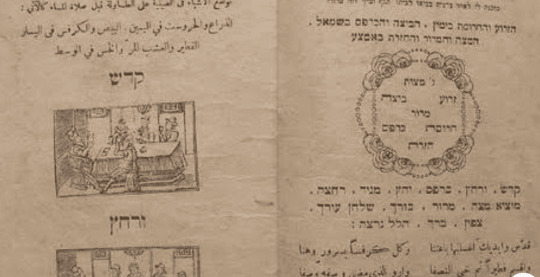
Egyptian Haggadah in Hebrew and Arabic1. Avoiding Beans and Rice: While it is well known that Ashkenazim universally avoid eating beans, legumes, corn and rice on Passover (this class of food is called kitniyot), not everyone knows that many Sephardic communities keep (some or all of) this custom as well. For example, Moroccans do not eat rice but do eat beans. Conversely, some Bukharian Jews do eat rice but do not eat beans or peas.Read: Why So Many Jews Don’t Eat Beans and Rice on Passover2. Eating Soft, Chewy Matzah:It’s fascinating to note that some Sephardic communities still bake soft matzah, which is significantly thicker than the cracker-like variety that has become virtually universal in recent centuries.3. Dipping in Lemon Juice: The most common custom these days is to dip the vegetable (karpas) in saltwater. However, some Jews, such as those from Kurdistan, traditionally dip it into sour lemon juice instead!4. Passing the Afikomen: Among the Jews of the Holy Land, there is a custom to take the afikomen and wrap it in a white cloth. This is placed on the right shoulder and transferred to the left shoulder. It is thus passed around the table from one to the next, with the last one to receive it reciting the verse: “Their kneading trays were bound in cloths on their shoulders.”That person then takes four paces and is asked: “Where have you come from?” to which they respond: “From Egypt.” “And where are you going?” “To Jerusalem.”Then all raise their voices and declare together: “Next year in Jerusalem!”Read: Why Do Some People Hide the Afikomen?5. Asking the Four Questions in Arabic: There’s no getting around the fact that the Seder is essentially a conversation, with the children asking questions and the Seder leader providing the answers—which is why many people say (parts of) the Seder in Arabic, Ladino, Farsi, or even English. So if you’d been a Jewish child in Yemen or Syria a generation or two ago, in all likelihood you would have learned to say the Four Questions in Judeo-Arabic.Read: The Four Questions in Nine Languages6. Waving the Seder Plate: Those using the Haggadah as recorded by Maimonides begin with the words, Bibhilu yatzanu miMitzayim, “We left Egypt in a great hurry.” Many Moroccans have the custom of saying these words again and again, each time waving the Seder plate over the head of another person at the Seder. Only after everyone has had the Seder plate waved over their heads, do they continue with Hay lachma anya, “This is the bread of suffering … ”Read: The Passover Seder Plate7. Having the Kids Symbolically Leave Egypt: Many have the custom to give each child a bundle of matzah to drape over their shoulders and then take part in the following exchange (in Arabic):
Where are you from? From Egypt
Where are you going?
What do you carry?
Read: 14 Facts About Syrian Jews8. Watch Out for Those Scallions!

Among many Persian Jews, a favorite part of the Seder is playfully whipping each other with scallions. Why? To remember how the Jews were beaten by their Egyptian masters. Plus, it’s a great way to keep the kids awake and involved!
Read: 10 Facts About Persian Jews9. Smearing the Charoset on the Doorpost: Among some Moroccan Jews, it is customary to take some of the charoset left over after the Seder and smear it on the doorpost. It has been postulated that this is to recall the smearing of the blood on the Jewish doorposts back on the night of the Exodus (the very first Seder), as well as in anticipation of the Messianic era when, (according to the Book of Ezekiel,) sacrificial blood will be smeared on the doorway of the Holy Temple.1Read: 19 Facts About Moroccan Jews10. Announcing Moshiach to the Neighbors: If you were from Djerba, you may be accustomed to having one of your neighbors walk through the neighborhood with the afikomen tied up on his back, calling out, “Moshiach, son of David, is on his way!”May it happen soon!Read: 15 Moshiach Facts11. Gathering for Mimouna After Passover:

Moufleta pancakes and sweets at a Mimouna
After Passover concludes, Moroccan Jews hold a special celebration called mimouna. People visit each other’s homes to enjoy elaborately set tables, especially a crepe called moufleta.
The word mimouna means “luck.” On Passover, many people do not eat at each other’s homes since not everyone has the same standards. The post-Passover socialization demonstrates that there are no hard feelings.
Read article in full
44 notes
·
View notes
Text
I want to wish an amazing and meaningful Shavuot to all my Jewish followers
Eat some cheesecake in my honor!
#literally that's the best part of the holiday#all the dairy food#even tho i'm bukharian and we are allowed to eat meat on shavuot#jumblr#shavuot#jewish stuff#personal
24 notes
·
View notes
Text
The embroidered textiles are called suzanis. They are found in Central Asian and particularly associated with Uzbekistan, which is where Bukhara is located. Suzanis are gorgeous, and Uzbekistan overall is known for its incredible textile production and arts! Ikat print—via fabric dying and weaving and painting—is another staple of Uzbekistan’s design style.
Bukhara has Persian roots and was a prominent center of trade, scholarship, and culture along the historic Silk Road. Even today, Tajik (a language related to Persian) remains a dominant local language, rather than Uzbek (a Turkic language).
Bukharan Jews were part of a larger group of Persian-speaking Jewish communities that also lived in modern day Iran and Afghanistan, as well as other parts of Central Asia. This was distinct from other Soviet Jewish groups in Eastern Europe, who primarily spoke Yiddish in the late 1800s and shifted to Russian in the 1900s.
Bukharan Jews are one of the oldest ethnic-religious groups in Central Asia, and their roots go back hundreds of years. Sadly, they also faced many periods of persecution.
In the 20th Century, the Soviet Union’s policies stressed assimilation and the removal of religious practice. Soviet propaganda painted all the ethnicities within the USSR as living in harmony and being equal, but this was never really the case. Central Asians—who are predominantly non-white, secular Muslims—continue to face discrimination and stereotyping even today. Antisemitism was also ever present during Soviet times, especially during the 1950s-80s.
Despite their rich history and deep roots, Bukharan Jews became more and more isolated. Many emigrated out of Central Asia to find more welcoming spaces. (Overall, Jewish out migration accelerated approaching and after the USSR collapsed in 1991.) A particularly notable community of Bukharan Jews settled in Queens in New York City. If you’re in the area, you should try to find some Uzbek food—like the textiles and art, the food is also incredible.
This was a super brief take! Here are some resources to read more:

In the former house of a wealthy Jewish merchant, Bukhara, Uzbekistan, 19th century.
#bukharan jews#uzbekistan#jewish#folk art#art#jumblr#ikat#suzani#bukharian Jews#bukhara#history stuff#Jewish emigration#rego park#queens nyc#Бухарские евреи#ussr#Central Asia
242 notes
·
View notes
Text
Diet plays a significant role to our health. The diversity that comes with cultural cuisine has positive and negative impacts on our health that some of us may not even be aware of. Growing up in a Bukharian Jewish family, we ate meals that contained rice and meat almost 4 times a week. Futhermore, in our culture, a simple one course meal is not enough, there needs to be varieties of salads and pickled vegetables that accompany it. I wont deny that eating a good meal brings one a sense of warmth, comfort and happiness, however it can potentially lead to diseases, complications, and overall unhealthiness. Some famous foods in my culture are; “Pilaf”, which is a dish with fried onion and carrots with meat and rice. Another is “Baxsh”, which also consists of meat and rice and chopped cilantro and scallions.
I think its very important to understand nutrtion and know how certain cultural diets can effect our health. Eating too much meat, carbohydrates, sugars, fats, oils, etc., can eventually lead to heart problems, diabetes, obesity, high cholesterol and more. “School based nutrition education programs targeted toward very specific eating behaviors are showing very promising results in regard to behavior and attitude change of children and adolescents. Substantial changes in health care providers’ attitudes and practices and in the funding and financing of health care will be needed if nutrition education is to be delivered in the context of routine health care.” (Reddy S, Anitha M., 2015). Its important to continue implementing the importance of health care in terms of every day diet so we can prevent future health complications.
I feel that as future nurses, when assessing a patient we need to take cultural cuisine into consideration at times as well and when providing the patient on patient teaching, diet and positive nutritional behaviors are always important to address.
https://momentmag.com/bukharian-cuisine-taste-silk-road/
https://biomedpharmajournal.org/vol8octoberspledition/culture-and-its-influence-on-nutrition-and-oral-health/
-Alena Sadiyayeva

0 notes
Text
Plov is a rice pilaf-style dish that became popular in the Soviet Union by way of Uzbekistan. Plov’s popularity in Russia can be traced back to at least the time of Alexander the Great. Upon returning from Central Asia to Macedonia, his soldiers were said to have brought back plov as one of their new favorite foods. The existence of this dish in Central Asia has a distinct tie to the Jewish community there. The Bukharian Jews of Central Asia are Mizrahi Jews whose lineage goes back to the time of King David and ancient Persia. During the reign of Persia’s Cyrus the Great, Jews made their way to Central Asia and formed a community where they eventually spoke a dialect of Persian called Bukhori. Central Asian versions of plov, particularly the Uzbeki variety, were later popularized across all Soviet republics during the time of the Soviet Union.
Plov can be similar to Indian pulao or Spanish paella, though ultimately, there are countless cultures that have some version of a one-pot rice and meat dish.
Soviet-style plov is most commonly made with lamb as its meat, carrots as its vegetable, and is typically spiced with cumin and coriander. However, you will find a wide range of plov made with different kinds of meat or poultry, spices, and even the addition of dried fruits or nuts.
I prefer to keep plov simple with traditional flavors. I use chicken thighs for their availability and affordability, and add loads of carrots and onions, which seem to magically disappear into the rice once cooked. Garlic, bay, cumin and coriander perfume this plov. This dish is a one-pot meal. Once all of the ingredients are prepped, it comes together quickly and then gets popped into the oven to finish cooking. It reheats and freezes well, and is hearty and filling.
5 notes
·
View notes
Text
From Turkey to Armenia, Uzbekistan to Ukraine, manti are a popular comfort food found in Jewish and non-Jewish communities across Central Asia and Eastern Europe. As an ancient form of dumpling, some trace manti’s origins back to the 1300s during the Mongol Empire in Turkey, while others credit the dish as a gift of the Silk Road; notably, Uyghurs from Northwest China have been making a version of bread prepared in steam known as “mantau” for centuries. Regardless of their origin, manti traveled East toward Korea, West towards the Caucuses and everywhere in between.
While their popularity spans continents, their shapes and styles differ by region. In Turkey they’re often formed into small pyramid-like pouches, sometimes baked and simmered, sometimes boiled, often topped with yogurt, and served in a tomato-based broth or sauce. On the other hand, the ancient Bukharian Jewish community in Central Asia are known for large intricately shaped manti, generously filled with meat and always steamed — never boiled. There’s also a dairy version of Bukharian manti that’s filled with cheese and served with yogurt.
Like many celebratory old-world foods, these hand-formed dumplings take a bit of time and effort to prepare, making them ideal for calling a helping hand into the kitchen. Historically, this dish was even a communal activity. While making homemade dumpling dough can be deeply satisfying, you can simplify the manti-making process by using store-bought wonton wrappers – a tip I happily discovered in Gabrielle Hamilton’s “Prune” cookbook. Given the labor, whether it’s with store-bought or homemade wrappers, when I make manti I often double the recipe, freezing extras for future enjoyment.
Let me preemptively warn you, this manti recipe may not look or taste like the manti you’re familiar with. After exploring different shapes, sizes and toppings, my preference is for smaller-sized manti shaped into pouches. I serve mine in a Turkic-inspired brothy tomato sauce topped with fresh herbs and a sprinkle of lemony sumac; the sweet and sour savoriness of the caramelized tomato complements the heartiness of the delicate beef-filled manti. I’ve provided directions for steaming or boiling your manti, depending on your preferred technique. If you find yourself hoping for a larger-sized manti, the dough can be filled and shaped according to your family’s custom. Whether you stick to the recipe as written or try something more traditional to you, the joy of manti lies not in their size or shape, but in their pillowy soft tenderness, and the inherent comfort they bring to every table.
Notes:
This recipe makes 48 dumplings.
I use Diamond brand kosher salt for this recipe, if using Morton’s or sea salt use ⅓ less.
The tomato broth (Steps 4-7) can be made several days in advance and reheated as needed.
You can freeze your shaped manti (homemade or with wonton wrappers) before cooking on a baking sheet. Once the manti are frozen, transfer them to a Ziploc bag or airtight container. They can be cooked from frozen the same way as they are from fresh.
12 notes
·
View notes
Text
Plov is a rice pilaf-style dish that became popular in the Soviet Union by way of Uzbekistan. Plov’s popularity in Russia can be traced back to at least the time of Alexander the Great. Upon returning from Central Asia to Macedonia, his soldiers were said to have brought back plov as one of their new favorite foods. The existence of this dish in Central Asia has a distinct tie to the Jewish community there. The Bukharian Jews of Central Asia are Mizrahi Jews whose lineage goes back to the time of King David and ancient Persia. During the reign of Persia’s Cyrus the Great, Jews made their way to Central Asia and formed a community where they eventually spoke a dialect of Persian called Bukhori. Central Asian versions of plov, particularly the Uzbeki variety, were later popularized across all Soviet republics during the time of the Soviet Union.
Plov can be similar to Indian pulao or Spanish paella, though ultimately, there are countless cultures that have some version of a one-pot rice and meat dish.
Soviet-style plov is most commonly made with lamb as its meat, carrots as its vegetable, and is typically spiced with cumin and coriander. However, you will find a wide range of plov made with different kinds of meat or poultry, spices, and even the addition of dried fruits or nuts.
I prefer to keep plov simple with traditional flavors. I use chicken thighs for their availability and affordability, and add loads of carrots and onions, which seem to magically disappear into the rice once cooked. Garlic, bay, cumin and coriander perfume this plov. This dish is a one-pot meal. Once all of the ingredients are prepped, it comes together quickly and then gets popped into the oven to finish cooking. It reheats and freezes well, and is hearty and filling.
14 notes
·
View notes
Text
The Bukharian Jewish community, while little known by the world’s broader Jewish population, is certainly no stranger to the kitchen. With historical exposure to multifarious global influences, from Central Asia to Eastern Europe to everything picked up along the Silk Road, Bukharian cuisine reflects profound cultural fusion while maintaining its own unique flair. Here are eight essential Bukharian dishes that are worth a try:
Bakhsh
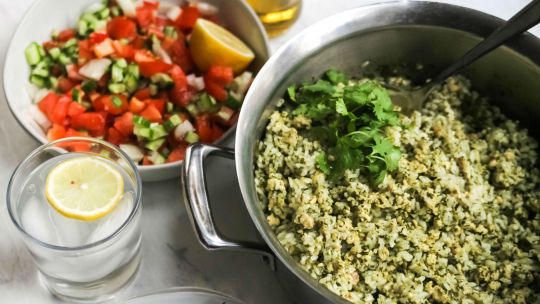
A staple in any Bukharian Jewish household, bakhsh is a rice dish easily recognizable for its distinctive green hue, which results from the addition of green herbs like cilantro and dill. Finely chopped meat or chicken, onions and other aromatics also feature prominently. Bakhsh is cooked using two primary methods — either by gradually layering the ingredients in a pot or submerging a bag with all the ingredients in boiling water. The latter preparation method, which allows the dish to be pre-cooked, was traditionally favored by Shabbat observers.
Osh Sovo
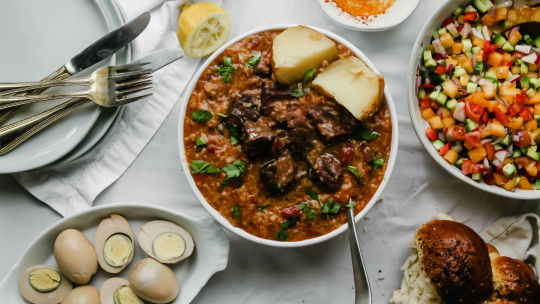
Another meal created to accommodate Shabbat, osh sovo is a slow-cooked fruity, meaty rice dish that is commonly served for Saturday lunch after being cooked overnight, beginning before the onset of Shabbat. The fruits incorporated into the rice are typically tangy and dry, often including prunes or dried apricots. Vegetables (such as tomatoes, carrots and potatoes) and spices (paprika or turmeric) are also thrown into the mix. The result is an incredibly silky, sweet-and-sour dish that’s a cross between a stew and a risotto.
Kov Roghan
This dish is simplicity at its finest — soft potato wedges are simmered with cubes of either chicken or meat in a broth to make for a heart- and soul-nourishing meal. Some soak up the remaining broth on the plate with lepyoshka, a round Uzbek bread adopted by Bukharians.
Osh Palov
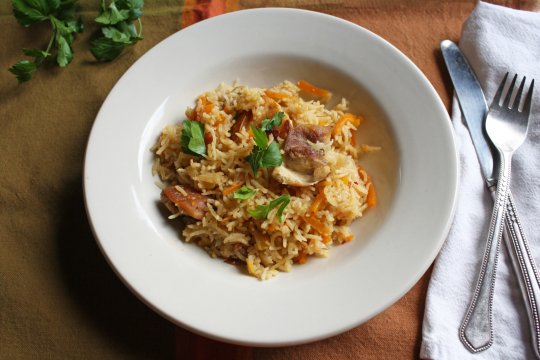
As Uzbekistan’s national dish, osh palov (also commonly called plov) has been adopted into a beloved food enjoyed at all sorts of Bukharian gatherings. To prepare it, chopped lamb is browned at the bottom of a large pot, after which thinly sliced carrots and onions are added, all topped with sticky and often oily white rice. Raisins, chickpeas and whole heads of garlic also typically adorn a large platter of plov, which often serves as the final course at large Bukharian dinners.
Osh Piyozi
Adopted from Afghan culture along the Silk Road, osh piyozi consists of softened, bite-sized stuffed onions. Fillings typically consist of a mixture of ground meat and rice, and the onions are often served in a sauce featuring tomatoes, dried fruits and peas, giving tasters a melt-in-your-mouth, umami bite.
Samsa

A cousin of Indian samosas, this baked savory pastry consists of triangle-shaped laminated dough filled with anything from ground meat and onions to pumpkin. While Uzbek households use butter or ghee as a laminate, Bukharians typically use non-dairy fats or opt for a non-laminated dough in order to maintain kashrut. One can often find a spicy tomato sauce beside a serving of samsa, which is meant to be drizzled into an opening in the pastry shell.
Sirkoniz

This rice dish can be perceived as a variation on osh palov, setting itself apart in two main ways: its distinct garlicky flavor and the fact that it is almost always served cold, another ancient Bukharian strategy for eating enjoyably while observing Shabbat.
Manti
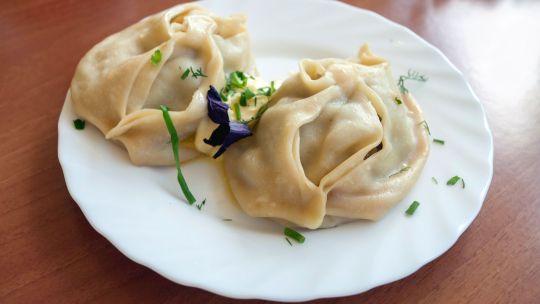
Adopted from Uzbek cuisine, manti are traditional steamed dumplings stuffed with ground beef and diced onions, often served with the same spicy tomato sauce used for samsa. Unlike some variations across the Caucasus, Bukharian manti are distinctly large, usually requiring a few bites to finish.
20 notes
·
View notes
Text
From Turkey to Armenia, Uzbekistan to Ukraine, manti are a popular comfort food found in Jewish and non-Jewish communities across Central Asia and Eastern Europe. As an ancient form of dumpling, some trace manti’s origins back to the 1300s during the Mongol Empire in Turkey, while others credit the dish as a gift of the Silk Road; notably, Uyghurs from Northwest China have been making a version of bread prepared in steam known as “mantau” for centuries. Regardless of their origin, manti traveled East toward Korea, West towards the Caucuses and everywhere in between.
While their popularity spans continents, their shapes and styles differ by region. In Turkey they’re often formed into small pyramid-like pouches, sometimes baked and simmered, sometimes boiled, often topped with yogurt, and served in a tomato-based broth or sauce. On the other hand, the ancient Bukharian Jewish community in Central Asia are known for large intricately shaped manti, generously filled with meat and always steamed — never boiled. There’s also a dairy version of Bukharian manti that’s filled with cheese and served with yogurt.
Like many celebratory old-world foods, these hand-formed dumplings take a bit of time and effort to prepare, making them ideal for calling a helping hand into the kitchen. Historically, this dish was even a communal activity. While making homemade dumpling dough can be deeply satisfying, you can simplify the manti-making process by using store-bought wonton wrappers – a tip I happily discovered in Gabrielle Hamilton’s “Prune” cookbook. Given the labor, whether it’s with store-bought or homemade wrappers, when I make manti I often double the recipe, freezing extras for future enjoyment.
Let me preemptively warn you, this manti recipe may not look or taste like the manti you’re familiar with. After exploring different shapes, sizes and toppings, my preference is for smaller-sized manti shaped into pouches. I serve mine in a Turkic-inspired brothy tomato sauce topped with fresh herbs and a sprinkle of lemony sumac; the sweet and sour savoriness of the caramelized tomato complements the heartiness of the delicate beef-filled manti. I’ve provided directions for steaming or boiling your manti, depending on your preferred technique. If you find yourself hoping for a larger-sized manti, the dough can be filled and shaped according to your family’s custom. Whether you stick to the recipe as written or try something more traditional to you, the joy of manti lies not in their size or shape, but in their pillowy soft tenderness, and the inherent comfort they bring to every table.
Notes:
This recipe makes 48 dumplings.
I use Diamond brand kosher salt for this recipe, if using Morton’s or sea salt use ⅓ less.
The tomato broth (Steps 4-7) can be made several days in advance and reheated as needed.
You can freeze your shaped manti (homemade or with wonton wrappers) before cooking on a baking sheet. Once the manti are frozen, transfer them to a Ziploc bag or airtight container. They can be cooked from frozen the same way as they are from fresh.
3 notes
·
View notes
Text
You may not immediately think of Jewish food when you hear the word “dumplings,” but there’s a surprisingly wide variety of them in the Jewish kitchen. From Bukharian dushpara to Persian gondi, Ashkenazi kreplach to Kurdish kubbeh, let these 10 comforting dumpling dishes soothe and nourish you:
3 notes
·
View notes
Text
Plov is a rice pilaf-style dish that became popular in the Soviet Union by way of Uzbekistan. Plov’s popularity in Russia can be traced back to at least the time of Alexander the Great. Upon returning from Central Asia to Macedonia, his soldiers were said to have brought back plov as one of their new favorite foods. The existence of this dish in Central Asia has a distinct tie to the Jewish community there. The Bukharian Jews of Central Asia are Mizrahi Jews whose lineage goes back to the time of King David and ancient Persia. During the reign of Persia’s Cyrus the Great, Jews made their way to Central Asia and formed a community where they eventually spoke a dialect of Persian called Bukhori. Central Asian versions of plov, particularly the Uzbeki variety, were later popularized across all Soviet republics during the time of the Soviet Union.
Plov can be similar to Indian pulao or Spanish paella, though ultimately, there are countless cultures that have some version of a one-pot rice and meat dish.
Soviet-style plov is most commonly made with lamb as its meat, carrots as its vegetable, and is typically spiced with cumin and coriander. However, you will find a wide range of plov made with different kinds of meat or poultry, spices, and even the addition of dried fruits or nuts.
I prefer to keep plov simple with traditional flavors. I use chicken thighs for their availability and affordability, and add loads of carrots and onions, which seem to magically disappear into the rice once cooked. Garlic, bay, cumin and coriander perfume this plov. This dish is a one-pot meal. Once all of the ingredients are prepped, it comes together quickly and then gets popped into the oven to finish cooking. It reheats and freezes well, and is hearty and filling.
14 notes
·
View notes